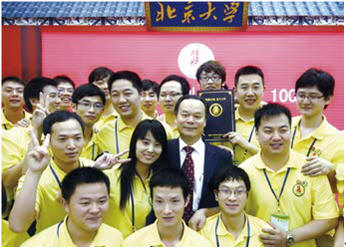China's latest five-year plan promises to shift the economy from its dependence on exports toward domestic consumption as an engine of growth. The key to achieving this will be for the nation to enhance the ability of its economy to innovate. Yet China's record on this score is mixed. Understanding why that is, and how to fix it, is important to estimating the likelihood China will succeed in its ambitious goals.
The first step is to appreciate the different kinds of innovation going on right now. When most people hear that word, they think of "inventing things," and on this score China is making progress toward becoming a more innovative economy instead of merely mass-producing goods that are designed elsewhere. China's spending on research and development has risen to 1.5 percent of GDP in 2008, from 1.25 percent in 2004, all the more impressive when you consider that GDP itself increased dramatically during that period. While China is unlikely to meet the goal of 2 percent set for 2010 in the last five-year plan, it still accounts for 12 percent of global R&D spending.
Significantly, this R&D spending is shifting from government-controlled research institutes to large- and medium-sized enterprises, which now account for 60 percent of total R&D spending. Despite frequent complaints about lax intellectual-property protections, foreign- invested companies account for fully 7 percent of this spending, spread among nearly 1,500 R&D centers established by multinational companies.
In some areas, such as telecommunications and pharmaceuticals, innovation shows through in the market. Local companies and universities have discovered multiple chemical compounds in China. Researchers such as Yi Rao and Shi Yigong, experts in genetics and structural biology respectively, are regarded as world leaders in their fields. Huawei's and ZTE's global gains in market share have shifted from being solely on the basis of cost to a combination of cost and innovation. For example, Huawei has developed the world's first "100G" technology capable of delivering large amounts of data wirelessly over long distances. Overall, China for the first time is likely to overtake the United States for number of patents filed in 2010.
Yet despite so much progress, all this industrial innovation misses other, potentially more important, forms of invention. Much of the best innovation in China today is built around developing creative business models in addition to, or instead of, new physical products. Broad Air Conditioning developed a way to commercialize gas-powered air conditioning systems for large buildings. Alibaba built a new business around an online platform to connect smaller Chinese producers with buyers abroad.
This is all possible because Chinese policy makers have learned some important lessons from earlier innovation failures—the biggest being that it's hard to impose innovation from the top down. This was especially apparent in the attempt to develop an indigenous technological standard for mobile telephony, when servicea-ble alternatives already existed. After investing billions to develop and commercialize the TD-SCDMA technology, Beijing has found few takers in China or elsewhere.

Beijing is also experimenting with a different innovation model that focuses on identifying opportunities earlier and creating incentives for market participants to innovate. Electric vehicles will be an important test here. This is an industry that is still very much open to innovation at the global level. Beijing is planning to invest $8 billion in R&D at various companies in an attempt to meet a numerical target for market size by 2020. Government commitments to buy the cars for official fleets combined with incentives to consumers will guarantee a certain amount of demand. But, crucially, the actual innovation will be left to the private sector.
Predictably, weak spots remain. In consumer electronics, for example, innovations tend to be derivative—refining products developed in Japan and South Korea instead of developing fundamentally new products. Innovation based on careful study of consumer preferences is rare, especially when the consumers are outside of China. Chinese companies still place too much focus on expanding global market share with just-good-enough products instead of creating markets with totally new products. And in state-dominated service sectors such as banking, there has been limited product or service innovation.
More broadly, there is still the question of how well policy makers will pick the areas where it makes sense to innovate. Although support for electric cars is promising, China is effectively ceding innovation in traditional combustion-engine cars to Indian companies such as Tata. This is a policy gamble given the potential size of China's market for regular cars. Indians are pushing the envelope with designs such as the world's cheapest car, the Nano. They are also finding that innovation in a traditional area can lead to innovation closer to the technological edge—for example, the plan to build a battery-powered Nano.
There is no reason China shouldn't aspire to that kind of innovation as well. The evidence to date shows that, given the right incentives, Chinese scientists, engineers, and entrepreneurs are eager to rise to the challenge of developing products for the global market. The policy challenge will be unleashing that innovation.

See More: Innovation in China: Copy Cat? Innovation Tiger?





